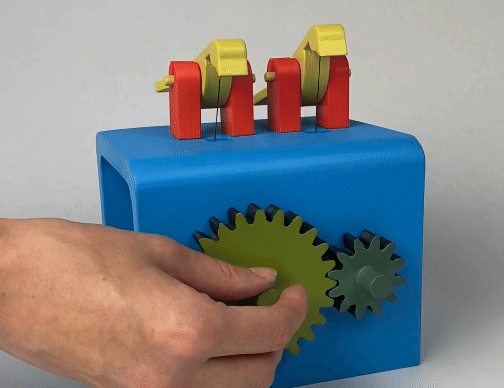
Children's Learning Toy
Spinamal
Designed a children's learning toy that teaches children the idea of using gears to translate rotary movement into linear movement.
Info
Case Study
Addressing the gap in access to library infrastructures in India
Role
Conceptualized, designed, and oversaw the development of the app from start to finish
Timeline
January 2023 - January 2024
Tools
Cad Modeling, 3D Printing, Finishing Parts, Painting

Design Challenge
How do I make an educational stem toy engaging for children?
This toy should be aimed at developing a child’s physical and mental capabilities, especially those related to but not limited to motor skill development and cognitive skills that are essential to a child’s growth.
Design Solution
Design a toy that teaches stem concepts through repetition & pattern recognition with the help of imaginative play.

White Paper Research
Children learn best when they...
1. Engage in Active Play
There is a direct link between play and the development of cognitive skills.
The review identified 323 studies from around the world supporting a link between learning through play children’s holistic skills in all five main areas: cognitive, social, emotional, physical and creative skills. The highest number of studies focused on a link between learning through play and cognitive skills.. This may be because of the attention that has been paid to cognitive skills in education systems and academics across the globe, as well as the availability of measures to capture these skills. source

2. Taking Charge of their Play
“It’s the difference between challenging children to build a tall tower that won’t fall over (guiding) and simply telling them to widen the base (instructing)”
When children get to make choices, try out different methods, and lead their own experiments, it makes all the difference to their learning. That doesn’t mean adults shouldn’t get involved. Just that we need to think in terms of guiding, rather than instructing. source
3. Perform Tasks Repeatedly
Repetition is the first principle of all learning.
Not surprisingly, research has shown that children learn better from reading a book over and over again than just reading it once or twice. In one study, researchers presented 3-year-old children with the same new words in three stories over the course of a week. The new words were exactly the same for all children, but half of the children were presented with the words in the same exact story repeated three times, while the others heard the same words in three different stories(Horst, Parsons, & Bryan, 2011). source
Needfinding

Values
Parents and Children Need
-
Self-Correcting Toy
-
Pattern Recognition
-
Repetition


Prototyping
From cardboard prototypes to 3D printed models for children...



